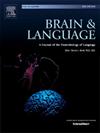句子理解中违反两种不同类型礼貌准则的共同和不同的ERP反应。
IF 2.3
2区 心理学
Q1 AUDIOLOGY & SPEECH-LANGUAGE PATHOLOGY
引用次数: 0
摘要
通过ERP实验,探讨了两种礼貌准则(自我贬低和他人提升)在线加工的神经认知机制及其在句子阅读过程中的个体差异。当参与者阅读包含语用恰当或不恰当的敬语或谦卑用语的句子时,记录脑电图。当对所有参与者的数据进行折叠时,不恰当的谦和敬语分别产生了N400和P600效应,这分别反映了语义处理成本和复核过程。更重要的是,沟通能力调节了N400和后期的负面效应对谦逊而非敬语恰当性的影响。相比之下,换位思考和强调关注分别调节了敬语的N400和后期正性效应,而不是谦卑语。此外,还观察到个体变量对适当性效应的调节具有一定的共性。这些结果讨论了句子理解过程中不同礼貌准则加工的神经认知机制的共性和个性。本文章由计算机程序翻译,如有差异,请以英文原文为准。
Common and distinct ERP responses to violations of two different types of politeness maxims during sentence comprehension
An ERP experiment was conducted to investigate the common and distinct neurocognitive mechanisms underlying the on-line processing of two types of politeness maxims (self-depreciation and other-elevation) and the individual differences during sentence reading. Electroencephalograms were recorded while participants read sentences containing pragmatically appropriate or inappropriate honorific or humble terms. When collapsing all participants’ data, inappropriate humble and honorific terms elicited N400 and P600 effects, respectively, which could reflect semantic processing costs and rechecking processes, respectively. More importantly, communication abilities modulated N400 and late negativity effects for appropriateness for humble but not honorific terms. In contrast, perspective-taking and emphatic concern modulated N400 and late positivity effects, respectively, for honorific but not humble terms. Moreover, some commonness of the appropriateness effect modulation by individual variables was also observed. These results are discussed in terms of the commonness and individuality of neurocognitive mechanisms underlying the processing of different politeness maxims during sentence comprehension.
求助全文
通过发布文献求助,成功后即可免费获取论文全文。
去求助
来源期刊

Brain and Language
医学-神经科学
CiteScore
4.50
自引率
8.00%
发文量
82
审稿时长
20.5 weeks
期刊介绍:
An interdisciplinary journal, Brain and Language publishes articles that elucidate the complex relationships among language, brain, and behavior. The journal covers the large variety of modern techniques in cognitive neuroscience, including functional and structural brain imaging, electrophysiology, cellular and molecular neurobiology, genetics, lesion-based approaches, and computational modeling. All articles must relate to human language and be relevant to the understanding of its neurobiological and neurocognitive bases. Published articles in the journal are expected to have significant theoretical novelty and/or practical implications, and use perspectives and methods from psychology, linguistics, and neuroscience along with brain data and brain measures.
 求助内容:
求助内容: 应助结果提醒方式:
应助结果提醒方式:


